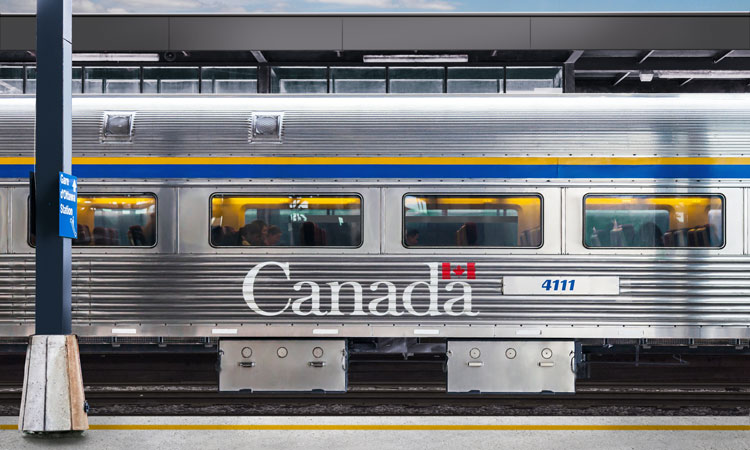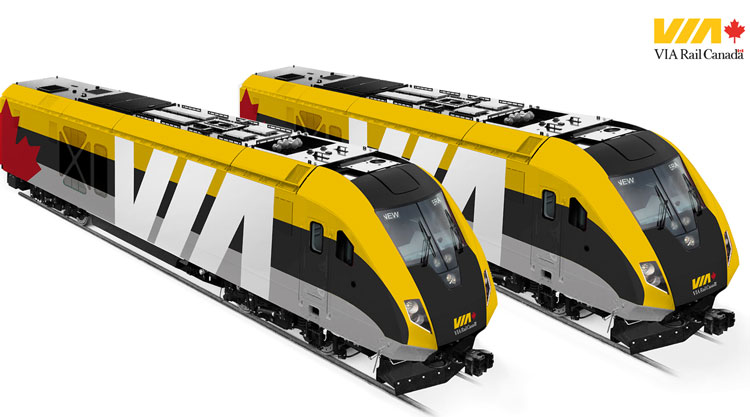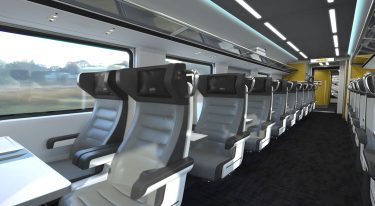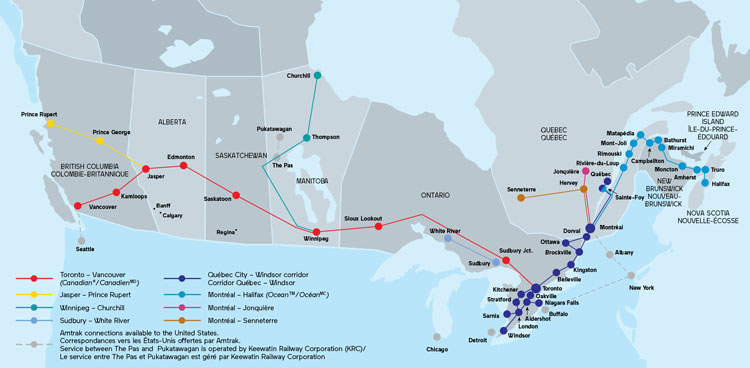Bringing VIA Rail to the next level: New fleet and new railway
Posted: 17 February 2021 | Cynthia Garneau | 10 comments
Cynthia Garneau, President and Chief Executive Officer of VIA Rail Canada, details the ambition behind restoring the critical role of passenger rail in Canada.


Credit: VIA Rail Canada
The history of rail is intimately linked to that of Canada. The initial national railroad was built with the intent to connect communities in order to move goods and people, therefore playing a crucial role in the socio-economic development of this vast country.
Now, after five consecutive years of ridership and revenue growth up until 2019, VIA Rail Canada (VIA Rail) is reaching a new milestone: Restoring the critical role of passenger rail by changing the way that we are moving forward.
Giving passenger rail a second life
Since 2014, VIA Rail’s ridership and revenues had continuously been growing, and had culminated with very promising results in 2019: More than five million passengers travelled onboard our trains, a record of the past 30 years, and revenues surpassed $400 million, a first in our history.
The 32 per cent ridership increase (between 2014 and 2019) reflected the renewed interest of Canadians for the train. However, it demonstrated another key element: That passenger rail had, yet again, become a viable transportation option for a wide array of customers. Whether it be businesspeople, students or tourists, the safe, sustainable, accessible, efficient and comfortable experience offered was convincing more and more Canadians to pick rail.
2020 then came with its share of challenges, rocking society to its core. From the blockades in February 2020 to the ongoing pandemic, VIA Rail was severely impacted, like others in the transportation industry and beyond. While we continue to manage the impacts of the pandemic, these consecutive crises highlighted our resiliency and determination – which will be crucial in starting VIA Rail’s next chapter.
Without any doubt, 2020 brought unique hardships and lessons. However, we never lost sight of our future and of our vision to be the smarter way to move people – and the answer to fulfilling it lies in our mission: Passengers first.


Starting in 2022, VIA Rail will welcome passengers onto the first of 32 state-of-the-art bidirectional trainsets for use in the provinces of Québec and Ontario. Credit: VIA Rail Canada
Our mission: Passengers first
Passengers are at the heart of everything we do, and we always strive to answer and exceed, to the best of our abilities, their expectations. This is in part achieved by constantly working on improving our services and finding better ways to connect Canadian communities.
From environmental to social and economic considerations, our objective is to continuously align with our passengers’ needs. Whether it be the reduction of road congestion, or using a more sustainable and efficient means of transportation, our customers find what they are looking for in the train.
But we cannot stop there, and while there is great potential in today’s service offering, fulfilling our mission and restoring the critical role of passenger rail depends on two factors, which are at the source of our growth. First, our access to the infrastructure. VIA Rail only owns three per cent of the tracks on which it operates, sharing access with freight operators, which in turn impacts schedules, frequencies and, therefore, the overall number of seats that we can offer across the network. Second, our aging equipment affects the level of comfort that we are able to provide to our passengers.
For all these reasons, we have been working for several years now on our modernisation programme, which will, undoubtedly, transform passenger rail service in Canada.
Modernising passenger rail service in Canada
Despite the pandemic, we have been advancing on our various modernisation projects to enhance several aspects of the customer experience.


Credit: VIA Rail Canada
First, the Heritage Fleet Refurbishment Program consists of modernising and refurbishing HEP cars. Using the ‘reuse-recycle-repurpose’ approach, we are improving the interior design and comfort of our train cars, which will be deployed on VIA Rail’s various routes, such as, amongst others, the Canadian, the Ocean and some regional routes.
We have also been hard at work on our Corridor Fleet Replacement Program. Starting in 2022, we will be welcoming passengers onto the first of 32 state-of-the-art bidirectional trainsets for use in the provinces of Québec and Ontario, where we served more than 4.7 million passengers in 2019. From universal accessibility and wider seats, to the use of some of the most energy-efficient technology around, VIA Rail will provide a greener, more accessible and more efficient travel experience to Canadians.
Finally, our modernisation programme would not be whole without our flagship project: High Frequency Rail (HFR), a large-scale and environmentally friendly endeavour which consists of upgrading and building new tracks dedicated to passenger trains between Québec City and Toronto. This will allow to connect more – and new – communities together, provide more departures, improve on-time performance and reduce trip times. Furthermore, HFR will have a substantial economic impact and will also significantly contribute to the reduction of road congestion and, thus, greenhouse gas (GHG) emissions. We are hopeful of receiving a favourable response from the Federal Government soon in order to move ahead with the project.
Undoubtedly, these large-scale initiatives centred around the needs of customers are another step to restoring the critical role of passenger rail service in Canada.


Map of VIA Rails network. Credit: Via Rail Canada
Canada: A rail nation
We must not forget that this country is a rail nation. When looking ahead, the past always shines a light on what the next steps are. By providing sustainable travel solutions, we are modernising passenger rail service in Canada and, beyond that, we are returning to one of the basic elements around which the original railroad was created: Connecting as many communities as possible, from coast to coast.
Today, as the national passenger rail service, we have a responsibility to further that legacy. Our modernisation projects – more specifically, HFR – were conceptualised with the same nation‑building mindset as the original Canadian Railway. Over a century later, travel is changing, and so are we, but our raison d’être remains.
Let’s act today for a more promising tomorrow.


Issue
Related topics
Infrastructure Developments, Passenger Experience/Satisfaction, Rolling Stock Orders/Developments, Sustainability/Decarbonisation









A bit late to the party but on the subject of Edmonton to Calgary, Why not restore the rest of the old CN line that ran past Camrose and Drumheller? It used to be a VIA rail route in the early days anyway and with the exception of the ends of it (and the APR heritage railway in the center) most of the route would be exclusively VIA rail use.
Historically, CN has shown very little interest either in allowing Via Rail’s trains to meet their scheduled travel times on CN’s existing lines or following over three hundred million dollars spent by our federal government in constructing only an additional 70 kilometers of passing trackage rather than the envisioned 160 kilometers.
Consequently, travel times increased rather than decreased.
As such, Via Rail Canada absolutely did the right thing in proposing their HFR plan since it’s considerably more affordable and almost as effective as HSR, while also being much faster than driving compared to present, unreliable travel times using CN tracks.
HFR trains running at speeds of 110 mph or 177 kph shouldn’t be dismissed in favour of HSR since most train travellers in Europe, around 90 percent, actually use regular intercity and regional trains running at similar speeds to proposed HFR trains!
Just view the complete YouTube Canada video entitled ‘Train Driver’s View: Halmstad to Gothenberg’ to get a glimpse of just how fast 180 kph actually is in comparison to driving!
If we had anything similar to the above-mentioned in Canada, travellers would embrace HFR in droves!
I only hope that our federal government makes the timely decision to approve HFR as soon as possible!
Build new HSR tracks bewteen Calgary and Edmonton that is a good an profitble and needed place for high-speed rail and put electric trains.
Returning schedules dropped in 2012 and High Performance Rail that may be completed quickly and at moderate cost must be immediate objectives. Chris West St. Marys ON
The current concern is between Montreal and Toronto where CN prefer to remove VIA from their tracks due to increase freight traffic. Otherwise hope to re-route CN’s freight to use CP’s tracks further north or re-build an expensive route by straightening the abandoned rail route between Peterborough and Perth by ruining pristine landscapes. This will mean that all VIA trains will detour through Ottawa that may increase 6 to 7 hours between those two cities then train use will decline further.
Calgary’s rail line belongs to CPR, and until there is an agreement to run Via trains on their tracks, there will not be service to or from Calgary.
If you’re serious, instead of High Frequency Rail, why not High Speed Rail?
why is not Calgary included in the development with one million people no access to the rest of the country
How about including Thunder Bay ? You would have many more customers. How many people get on the train in Armstrong? I am guessing way less than what you would get here.
The system needs to restored Calgary to Banff …these area are hard hit by pandemic and survival on the tourist industry.